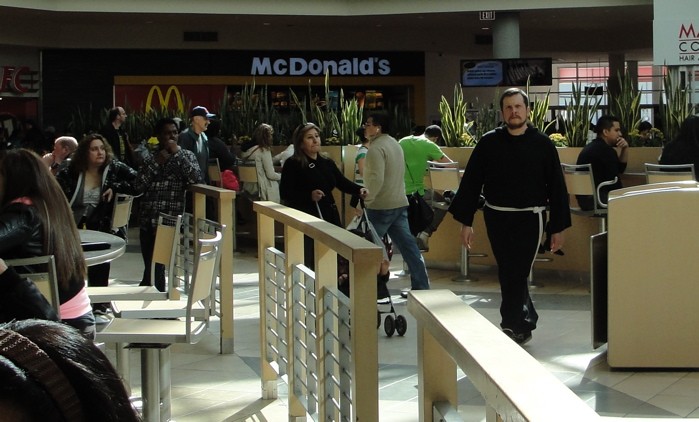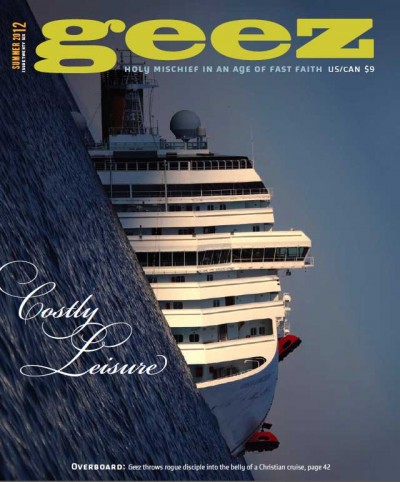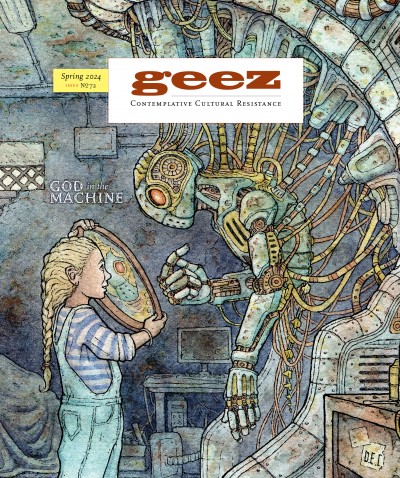(Dis)robe full interview

It took Rob Crosby-Shearer nine months to gather enough courage to wear the robe in public.
Credit: Rob Crosby-Shearer
In the fall of 2011, Toronto new monastic Rob Crosby-Shearer donned a brown monk’s robe as his only clothing. Geez editor Rachel Barber asked him what it was like.
First of all, how did the idea for the “(dis)robe experiment” come about? How long had you been thinking about it before putting it into action? And how long were you actually wearing the monk’s robe?
The idea has been floating around in my head for a few years. When I was a young Pentecostal kid, I was given some John Michael Talbot albums and there he was, this charismatic friar looking like St. Francis!
 Since then, I’ve been increasingly fascinated with the varieties of religious clothing that I see worn out in the neighbourhood – and what those outward expressions might reflect. Tibetan Buddhist monks, Muslims, Sikhs, Orthodox Jews and others – and then Christian monastics and friars – all of them have ways of expressing their commitment to their faith and community through clothing.
Since then, I’ve been increasingly fascinated with the varieties of religious clothing that I see worn out in the neighbourhood – and what those outward expressions might reflect. Tibetan Buddhist monks, Muslims, Sikhs, Orthodox Jews and others – and then Christian monastics and friars – all of them have ways of expressing their commitment to their faith and community through clothing.
It was after having a chat with an Anglican priest friend of mine about how our clothing should really reflect our theology, justice stance and community values that I actually started to take the idea seriously.
After that happened, I talked with my wife about how she felt about being married to well, uh, a “monk.” She was really supportive and actually excited. Nonetheless, the robe had been made for about nine months before I actually had the courage to wear it in public. I started wearing it (and blogging about it) on the feast day of St. Francis – October 4 – and I wore it six days a week for a little over two months.
Your initial goal for this experiment was to explore what it means to wear your faith on your sleeve. Through the course of it all, how did your goal change or evolve, due to your experiences? Did you end up with a new goal or focus?
I became increasingly interested in the usually subtle – and sometimes overt – interactions that I had would have with people as I wandered around my neighbourhood and while I was hanging out at places like the local nursing home or drop-in or shopping mall or farmers market.
I also became more interested in the counter-cultural, anti-consumer, human rights and ecological elements of owning only one set of clothes. Nonetheless, I think the primary piece for me was still to know what it felt like to actually be wearing one’s faith almost every time they were in public. What would it mean to be publicly identified as a follower of Jesus Christ wherever I went? How would that change how I acted? Or would it?
What was the overall response to your monk’s robe? Did you find that you were treated with more respect than before? Were you more approachable than before? Or were people hostile, or embarrassed to acknowledge your presence?
To be honest, in a place like Toronto, where there is a lot of diversity in clothing and expression, there wasn’t too much reaction on the streets. When there was, it was most often from those who might be called “street involved” who talked with me – often telling me stories of their own faith or asking why the hell a monk was carrying around a baby!
I would also run into a lot of ex-religious, as well as few current, Roman Catholic priests and laypeople who really did seem to treat me with a deeper respect – even when I explained the experiment to them. One woman, who was handing out a “hellfire and brimstone” tract in Mandarin folded her hands in a gesture of respect. That was a bit startling to me.
As for being more approachable, there were a number of times that people would approach me – but like I’ve said –most of those folks were street involved. The first time that happened was at a streetcar stop on my way to the first Toronto Occupy March with the toddler on my back! I got a lot of media attention at the march, though it was hard to explain to the media who I was in a soundbyte without detracting from the issues. At that march there were a lot of conversations.
Oddly, I never faced any outright hostility through the whole experiment. Some strange looks. Often people would look away – like I was naked or something – but I never felt any outright hostility. That might be about Toronto. Would things be different in Montreal? Or Flin Flon? Or even just outside Toronto?
If there was any hostility, it seemed to come from non-monastic clergy in the established church who felt I might be trying to come across as something I wasn’t. Quite possibly. On the other hand, all my “religious” (i.e. monastic/friar) friends seemed pretty charmed by the idea – almost like it was a tribute to them or something – which in a way, it was.
When (or where) were you most aware of your outfit? When (or where) were you most comfortable in it?
I was comfortable at home and in community and, interestingly at worship gatherings – though there were times in all of those contexts that I wondered if people didn’t think I wasn’t being a little over the top.
I was most aware of it when I would go to places in so-called “high” society. Like the theatre. That night watching My Fair Lady I felt really self-conscious (the blog entry about the washroom line was the peak of that – my habit didn’t have a zipper!) Generally speaking, in the city, I never felt too self-conscious.
There were times when I was at the park with the kids, or holding hands with my wife, that I really wondered about my privilege and how much I was appropriating something sacred and ancient that people have made a lot of sacrifices for – all for the sake of an experiment. But overall, I did feel like I was treating the “habit” with respect.
In your blog, you related an encounter with a former Catholic friar, who had left his vocation to marry and have a family. This made you aware of the privilege in your experiment, as you were wearing the friar’s clothing, while enjoying the benefits of family, as a husband and father. You were trying to participate in the best of both worlds. Have you thought any further about that? Is there any way to comfortably reconcile the two?
I thought about that aspect of privilege even before I started – and that concern almost made me not do it – and that question became stronger as I went along. Years ago I had talked with a Franciscan friar about his habit; his initial thrill and how his relationship with it had changed and if felt to him more like a millstone. Unlike he, who had taken a life vow to wear the thing, I was pledging to a mere few months.
There is a degree of appropriation and privilege that could be taken for granted about doing this as an experiment. At the same time, part of what I was doing was exploring how my radical Christian values might be able to re-engage and re-appropriate that “symbol,” which I know is a fine line. Still, I was pretty much treated with respect from the monastics and friars that I know.
The other thing to note is that there are increasing numbers of communities who do allow habits for married folk (such as Brothers and Sisters of Charity in Arkansas which was started by John Michael Talbot). It was the celibate Franciscan friend of mine who spoke of his troubles with the habit who wrote me the first note of support, which meant a lot to me. Nonetheless, I was constantly aware and at least slightly uncomfortable with the privilege I had around wearing the habit.
On a similar note, how did your robe-wearing affect your relationship with your wife and children? Have your family dynamics changed as a result? How did it affect the broader community in which you live?
Meagan (my wife) was super supportive and I think she’s hoping that I re-engage the robe. Still, I was always very aware around being in public with her with it. The children are pretty little. I was worried they might not recognize me, or think Daddy only wore dresses from now on, but they seemed pretty good overall. It might be different if they were 14 and not 2.
I live in a new monastic community (www.jeremiahcommunity.ca) and on the first day the whole community house where I live wore robes of some description or another in support. There were some folks in the community who joined along for a day or so during the experiment, including one person who wore a robe to his evangelical Bible College (and got more hostility there then I ever got, interestingly).
The robe raised a lot of dialogue in our community about the notion of radical public witness, and what it might mean to wear some kind of a habit – even as a new monastic community. I’m no expert on monastic history, but I’ve wondered if there isn’t something in the earliest impulses to wear a habit that’s being re-engaged by our young new monastic community in the (dis)robe experiment.

Credit: Rob Crosby-Shearer
When you cleaned out your closet in preparation for this experiment, where did you give all of your clothes? And where did you get clothes once your experiment was over?
I have a confession to make. I put most of my extra clothes in a plastic bag, but never actually finished the culling. I got so busy that I never gave them away.
To this day I still have 2 sealed bags of clothes in my closet that I really do intend to take down to a local drop-in that I hang out at most weeks. I don’t know if it was busyness, or something resistant in me to getting rid of them all. But that’s a part of the experiment that I still need to finish.
You reserved several articles of clothing, taking into account cold weather and other emergencies. Did you ever have to use those extra pieces of clothing? If so, what did that feel like?
Yeah, I negotiated with Meagan that on our family Sabbath I would go back into street clothes, both for the sake of our relationship and for the kids. That way, I wasn’t always “on duty.”
This is yet another example of the privilege in the experiment (though perhaps not so much post Vatican II, where a lot of religious, at least in North America, also have the option to wear the habit or not) . . . Other than that, I pretty much stuck to wearing the robe six days a week. I did wear thermal underwear a fair bit as well as hoodies and overcoats regularly.
The “day off” sometimes was a relief. Other times I was itching to get back into it and it really did feel like the habit was becoming part of my identity. I’m a pretty big introvert. In weeks where there were more interactions, I was pretty happy to be a little more nondescript and just fit into a crowd and be able to hold Meagan’s hand without wondering what people were thinking.
It only felt fair that I’d have one day with the family where I wasn’t likely to have some interaction with strangers about the robe pulling me away from focusing on being with them.
Why did you decide to end the experiment? Are you planning on resuming it at some point in the future? And if you choose to resume it, is there anything that you would do differently?
I ended the experiment because a senior person in the denomination I work for expressed some discomfort with the experiment. Though he could have, he didn’t actually tell me to stop, but noted that he felt that the habit represents a certain amount of formation and could be mis-read. He did mention that he had heard concerns from others too.
In order to not embarrass him, or my community, I decided to play it safe and put the experiment on hold while I thought that through a bit more and engaged more dialogue with people who are concerned. Having said that, I would love to re-engage the experiment – perhaps even as more than just an experiment!
That same Anglican Priest who I had the conversation with which gave me the confidence to do this has a Benedictine-style robe as his liturgical gown, and (believe it or not) he’s faced some hostility because of it from other clergy. I mention that because he has tried to align his vocation as a priest with his Benedictine values.
I think if I do re-engage this, I’d like to align my calling as a husband and father, as well as new monastic, with the clothes I wear and the witness I am called to live as a follower of Jesus Christ. At the end of the day, that might be a Franciscan-style habit or it might be a hoodie, who knows.
I’d also like to follow up on the concerns raised and be sure that I’m living the kind of formation that made the senior person in my denomination uncomfortable – and actually live the habit with integrity on every level. Who knows, maybe the experiment could actually evolve into a lived expression of covenanted community clothing?
I think that’s where it was heading when I stopped the experiment and maybe it will pick up again.
Lastly, would you describe your experiment as an act of love, directed outwards, or an act of meditation, directed inwards? Or is there a better way of understanding it?
I hope it’s both! It likely walked a line between both outward love and inward meditation. To be honest, I undoubtedly also had moments of narcissism – and it’s really important to keep checking one’s intentions in this kind of experiment.
Though love and personal challenge may be the primary motivations, it’s easy to turn the habit into something else. I wonder if traditional monastics and friars wrestle with that one. Overall, the inner challenge to live the values that I was “wearing” was a big thing.
Another way to understand it might be as public witness; towards simplicity, to reclaiming some ancient values, to the fact that “average” Christians can also engage their faith in a 24/7 kind of way, in ways that challenge us and challenge our culture. Even with the messiness of this particular experiment, I think Jesus would be OK with that.



Sorry, comments are closed.